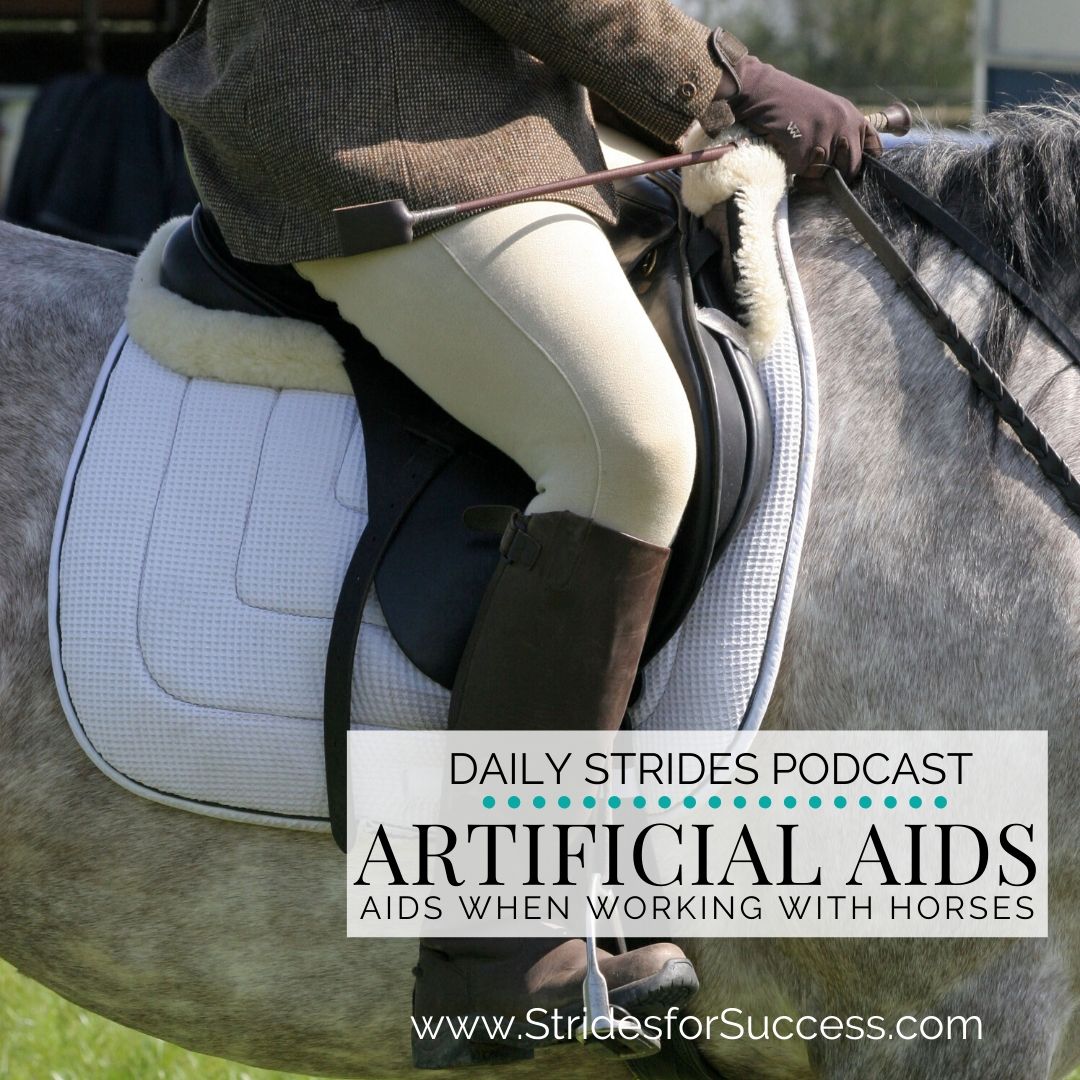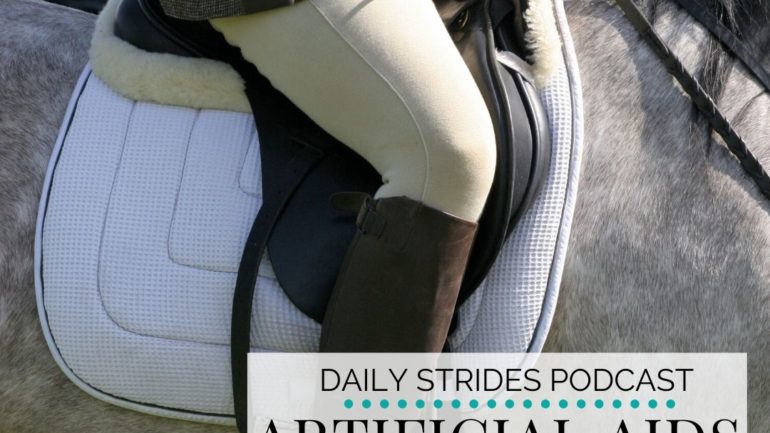
For some reason, many riders have a negative story around artificial aids. And yet, most riders use artificial ads on a daily basis, whether riding or on the ground with their hose.
What is important to remember is that artificial aids are neither positive nor negative.
They just are what they are. And you can use them to create a positive or negative reinforcement with your horse. And, let’s be honest here, you as well.
So in light of all that, I want you to begin being a little more mindful when using artificial aids with your horse. This will allow you to begin the process of figuring out when and how you can begin moving away from that aid and towards a more natural aid instead.
Why Artificial Aids?
Artificial aids help enforce boundaries. And boundaries are vital for both horse and rider. They help us to clearly communicate what we want and also allow our horses to clearly communicate back to us. Having no boundaries results in nobody really understanding what is expected of them.
Clear Boundaries = Clear Expectations
Many of your boundaries can be communicated and enforced using your natural aids. Your own voice, hands, legs seat, position, etc. However, there are times where an artificial aid is actually more helpful and less confusing for both horse and rider. A railing or fence around the arena for example.
I believe that the key to successfully using artificial aids is to realize that they are there to simply ‘back up’ or reinforce your natural aids.
They are not used on their own. Similarly, they should not be the lead in the conversation with your horse. However, they are a powerful tool, when used correctly, to clarify what you want to your horse.
What are Artificial Aids?
Simply put, it is something you can use that is not part of your body, to help explain or clarify something to your horse. Think of them as tools. You can pick them up and put them down when you want. Now, what is important to realize is that not all artificial aids can actually be ‘picked up’!
-
-
-
-
-
Bridle
-
Bit
-
Headcollar
-
Leadrope
-
Lunge line
-
Whip
-
Spurs
-
Arena wall
-
Stable wall
-
Groundpoles
-
-
-
-
All of the above are artificial aids. They are not part of your body, and yet they help you to more effectively communicate with your horse. This is especially true when your natural aids are being ignored or ‘missed’ by your horse.
When to Use Artificial Aids
Most riders will use some form of artificial aids from day 1 of their experience when working with horses. And most horses will see the aids as an extension of the rider and a part of the overall conversation. Artificial aids work just like your natural aids, in that it is all about pressure and release.
You can apply pressure using artificial aids and then release it when your horse responds
The amount of pressure is where many riders can have a negative narrative surrounding using artificial aids in their day to day riding with their horse.
However, like any aid, natural or artificial, excessive pressure comes down to the rider and how mindful they are when applying the aid.
Let’s take one of the more misunderstood artificial aid, the whip. I think that this is simply a case of something having the wrong name! If we referred to it as a ‘pointer’ or even a simple ‘stick’, would it have as much negativity attached to it? Either way, it has and because of this many riders refuse to ride with one.
But, is bruising your horse’s sides because you have to kick so hard any better than whipping your horse? Neither is right – and yet one is seen as being acceptable by many riders. This is something I take issue with. I personally feel that a ‘reminder’ or ‘pointer’ to pay attention to the rider’s leg is a lot nicer than kicking the sides off a horse… What do you think?
Consistency and Responsiveness
More often than not, artificial aids are simply there to ‘back up’ your natural aids. However, consistently is first required from the rider with regards to what they are doing at any given time. I believe that most responsiveness issues can be traced back to a rider who is ‘wishy-washy’.
If you are to use artificial aids to back up your natural aids, you must get clear on what you are doing and why.
So, let’s go to the whip again. It is important to first of all set things up. We usually use the half halt to do this. The half-halt is simply a way of bringing your horse’s attention to you and what you are doing in the saddle.
Once your horse is listening, you then decide where your aid will be applied and how much pressure is required. Then the aid must also be applied at the best time for your horse to take action and respond.
What many riders find is that, even if all of the above are consistently being communicated, their horse either misunderstands or ignores their leg aid. This is when I feel a schooling whip can add to the conversation. If used correctly, it simply brings the horse’s attention to the missed or ignored leg aid. A simple tap. Not a whip, lash, or strike. Just a simple tap, directly behind the leg aid, delivered immediately after the leg aid has been ignored.
Weaning Your Horse Off Artificial Aids
How long you want to continue to include artificial aids in your conversation with your horse will depend on your unique circumstances. Some riders feel the need to have a way to bring their horse’s focus and attention back to them immediately. Maybe while navigating a track of fences. Other riders want to move away from anything that is not as natural as quickly as possible. Artificial aids, when used correctly, are not wrong. They just are.
Often, if you begin to move away from them, both you and your horse must learn to trust and develop more confidence in yourselves and each other.
Take the boundary fence of the arena. If used consistently to help keep you both ‘straight’ when riding on the outside track, it will become a crutch. In fact, it will actually begin to negatively impact your development and training over time. But moving away from it requires confidence and trust.
It requires developing mentally, emotionally, and physically.
The same goes for the fence of the lunging arena. Or the arena fence full stop. On the ground, this can be the difference between begin able to tack up in a stable or out in the open.
Building Your Natural Aids
Again, artificial aids are neither good nor bad. How you use and apply them makes them so. But what is important is that you are always looking to developing yourself as a rider. Develop your natural aids. Your seat and weight aids. Voice is another important one. And, of course, legs, hands, body language and position.
Your most powerful aid, either in or out of the saddle, is your thoughts. You can use your artificial aids to clarify and improve your thoughts. doing this will, over time, improve your other natural aids as well.
Start with setting your boundaries. Get clear on what you want and your expectations surrounding everything in your riding. Then look at how you communicate and enforce this with your horse.
There is always a balance of aids at play in your conversation and it will evolve and change over time…
Happy Riding
Lorna
Additional Resources on This Topic
THINKING OF LUNGING YOUR HORSE?
A FREE CHECKLIST WITH THE 4 ESSENTIALS TO GET YOU STARTED...

